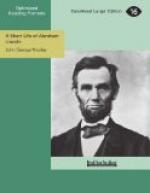[Footnote 1: By the law of primogeniture,
which at that date was
still unrepealed in Virginia, the family estate
went to Mordecai,
the eldest son.]
When Thomas Lincoln was about twenty-eight years old he married Nancy Hanks, a niece of his employer, near Beechland, in Washington County. She was a good-looking young woman of twenty-three, also from Virginia, and so far superior to her husband in education that she could read and write, and taught him how to sign his name. Neither one of the young couple had any money or property; but in those days living was not expensive, and they doubtless considered his trade a sufficient provision for the future. He brought her to a little house in Elizabethtown, where a daughter was born to them the following year.
During the next twelvemonth Thomas Lincoln either grew tired of his carpenter work, or found the wages he was able to earn insufficient to meet his growing household expenses. He therefore bought a little farm on the Big South Fork of Nolin Creek, in what was then Hardin and is now La Rue County, three miles from Hodgensville, and thirteen miles from Elizabethtown. Having no means, he of course bought the place on credit, a transaction not so difficult when we remember that in that early day there was plenty of land to be bought for mere promises to pay; under the disadvantage, however, that farms to be had on these terms were usually of a very poor quality, on which energetic or forehanded men did not care to waste their labor. It was a kind of land generally known in the West as “barrens”—rolling upland, with very thin, unproductive soil. Its momentary usefulness was that it was partly cleared and cultivated, that an indifferent cabin stood on it ready to be occupied, and that it had one specially attractive as well as useful feature—a fine spring of water, prettily situated amid a graceful clump of foliage, because of which the place was called Rock Spring Farm. The change of abode was perhaps in some respects an improvement upon Elizabethtown. To pioneer families in deep poverty, a little farm offered many more resources than a town lot—space, wood, water, greens in the spring, berries in the summer, nuts in the autumn, small game everywhere—and they were fully accustomed to the loss of companionship. On this farm, and in this cabin, the future President of the United States was born, on the 12th of February, 1809, and here the first four years of his childhood were spent.
When Abraham was about four years old the Lincoln home was changed to a much better farm of two hundred and thirty-eight acres on Knob Creek, six miles from Hodgensville, bought by Thomas Lincoln, again on credit, for the promise to pay one hundred and eighteen pounds. A year later he conveyed two hundred acres of it by deed to a new purchaser. In this new home the family spent four years more, and while here Abraham and his sister Sarah began going to A B C schools. Their first teacher was Zachariah Riney, who taught near the Lincoln cabin; the next, Caleb Hazel, at a distance of about four miles.




